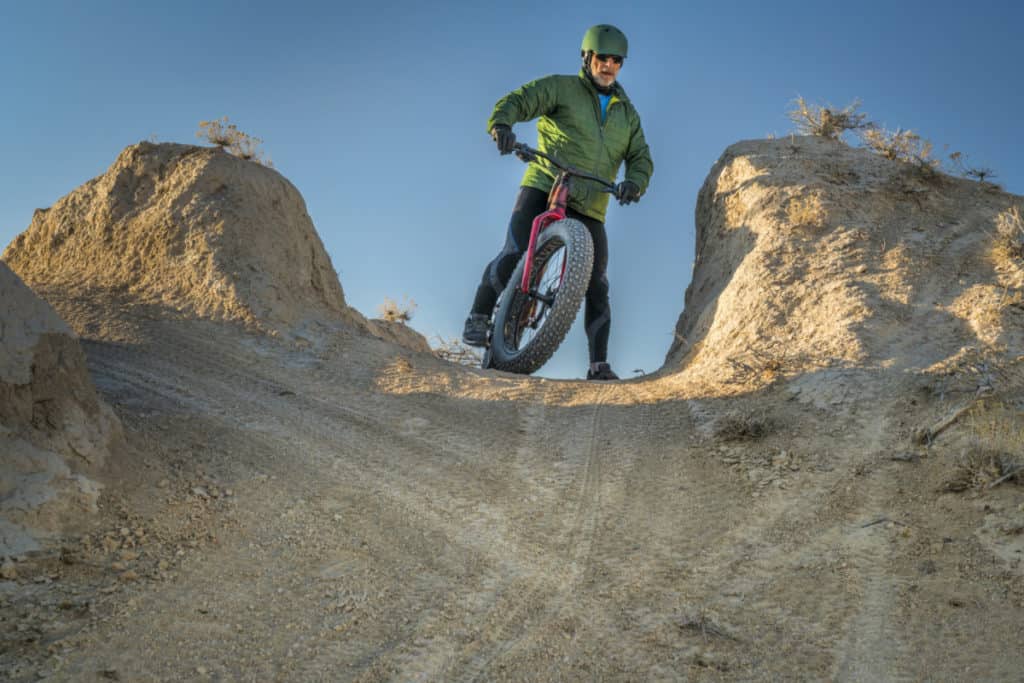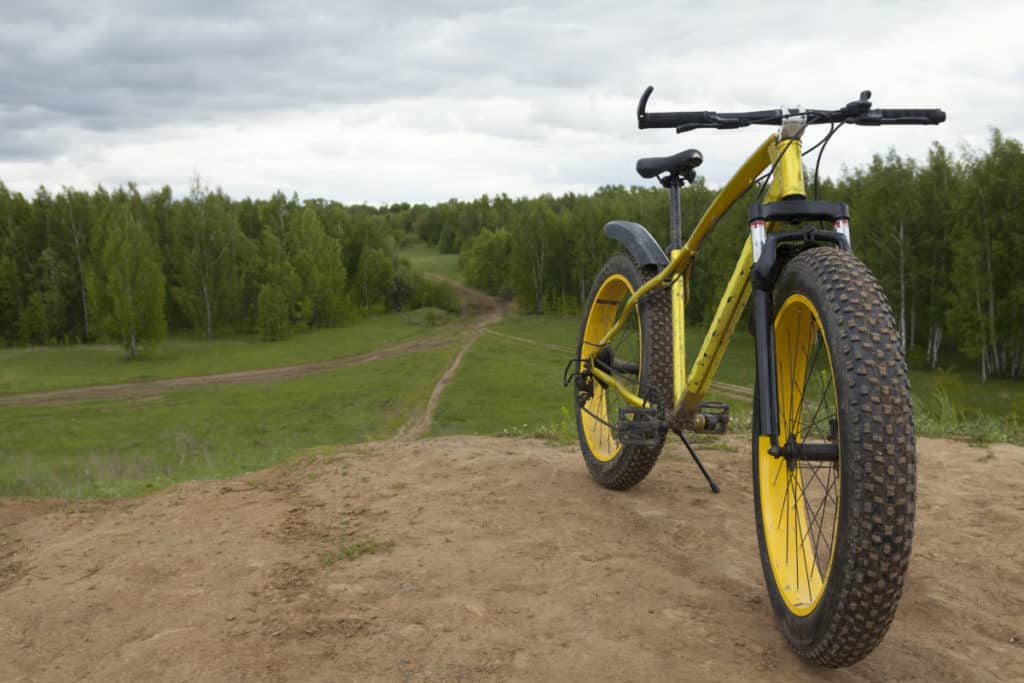
Seeing a fat bike for the first time is often bewildering, mainly because it looks like a child bike with very fat tires. Unlike standard tires, the fat bike tires are usually between 3.8 inches to 5 inches or more. The distinguishing factor between mountain bikes and fat-tire bikes is that you can use the fat bikes on almost all terrains. This is because the bikes have very high suspension thanks to the low-pressure tires that allow them to float even on soft surfaces.
But how are fat tire bikes to ride? Well as you may have guessed from there wide tires they are harder to pedal. Most fat tire bikes will be about 15% to 20% harder to pedal then other bikes. But do to the extra-wide tires they are
So they might be better for someone who hasn’t been on a bike for a few years even if they are harder to pedal. Here is a detailed guide on fat-tire bikes and their advantages.
How sturdy is a Fat Bike Cycle?
The wideness of the fat bike tires gives them better traction on the most unstable terrains. This is because the low pressure allows them to cruise at relatively lower speeds compared to other bikes. The stability of the fat bikes is incomparable to any other bike cycle. That’s why there preferred by novice riders.
Whether you want to ride on the regular ground or even on the most impassable terrains, this bike should be your go-to. Besides, the wide tires give the bike better balance compared to other bikes with
It would seem impossible to go through sand or even snow coverd ground using standard bikes because they tend to sink in the soft fields. However, the thick tires give your bike cycle a larger surface area that enables you to remain afloat.
Why are Fat Bikes Harder to Pedal?
It’s an undeniable fact that riding a fat bike requires much more muscle for pushing. You can, therefore, expect to use more energy riding a fat bike compared to other bikes. This is because the low pressure on the tires creates extra traction that makes it harder to get the
Riding the bike on rough grounds, however, becomes more comfortable than on smoother terrains because the bikes are designed for these grounds. On the flip side, though, it can help you with your workouts because you lose more calories riding a fat bike than a standard bike. You even get to work out during the winter season because it can climb up the snow mountains without a hitch.
However, as you ride a fat bike on slippery grounds such as snow or sand, you can expect increased resistance requiring you to use a lot of energy to pedal. This is because the increased traction and low speeds do not give you the required momentum for a smooth ride.
The weight of the bike often determines how hard it is to pedal. The more massive a bike
Luckily these days, inventors have come up with carbon fiber rims and frames that are super light. However, these modifications come at an extra cost the lighter fat bikes cost more than the heavy ones. Of course, not everyone can afford them but they are well worth the investment.
Can I Ride a Fat Bike on The Road?
Not everyone can afford to have a bike for every season and terrain. The fat bike is designed such that it can cruise on all these landscapes. Besides, a fat bike is relatively pricier compared to other narrow bikes. Therefore, the fact that it can be used anywhere makes it the ideal bike for all-season usage.
It is no wonder that these days you find so many fat bikes outside grocery stores and in the malls. However, if you love speed on the road, you might not achieve that with the fat bike. It may be slower, especially if you don’t have the strength to pedal faster. The slow speed is due to the low
One way you can improve the speed of your fat bike while on the road is to increase the pressure of the tires. It isn’t recommended that you put the pressure
Which bicycle is Better, a mountain bike or a fat bike?

If you want a faster bike, then opt for a mountain bike because the fat bike has a lot of rolling resistance. This implies that you have to use a lot of energy to pedal and also, when going uphill, the pedaling can be tedious.
The mountain bike, on the other hand, has thinner tires that make riding faster and easier. However, if you want comfort and fun, then the fat bikes make a better choice. The thick tires and rims offer better shock absorption especially when going through rough paths.
If you’re a newbie rider, the fat bike is a good option because it gives you the stability, comfort, and fun of riding all year round, albeit the slow speed. The mountain bike despite
How to Choose the Right Fat Bike
Even though fat bikes are versatile and fun to ride, they come in different varieties and sizes. Here are some of the factors to consider when buying a fat tire bike.
- Floatation
The first thing to consider should be the floatation of your bike. The thickness of the tires and rims determines how well your bike can float on soft surfaces. If you want a bike to use on rough, sandy, or snowy terrains then get one with the widest tires that you can get. However, if you want a bike to use around your home, then you don’t need the
The rims of the bike also affect floatation depending on their thickness. Ideally, the rims should fit well in the fat tires to avoid deformation of the tire shape, which could lead to instability. For instance, a 3.8-4 inch tire can fit a rim between 65-80 mm wide. All rims have widths ranging between 65 mm to 105 mm. As such, it’s upon you to identify one that perfectly fits into your tires.
- Braking system
The frame of a fat bike cannot sustain a conventional braking system. Therefore, most fat bikes use mechanical disc brakes that are harder to service and maintain. Some manufacturers also use of hydraulic brakes.
Hydraulic brakes are, however not suitable for all regions especially if the brakes make use of mineral oil. Mineral oil tends to have a high operating temperature and can quickly freeze in cold temperatures.
- Size of the bike
Depending on your weight and height, you have to choose a bike that suits your needs. Most fat-tire bicycles have rigid frames that make your standover height rise. The carbon fiber frames come in about 4 sizes to
- Gears
Gears are an essential component of a fat bike. Ideally, you should get a bike with a range of gears. It’s near impossible to get started in a high gearing because of the increased traction from the wide tires. Therefore, ensure that the bike has low gears to improve comfort as you pedal.
- Suspension
The suspension of a fat bike is vital, especially if the bike is meant for harsh landscapes. Most fat bicycles have a rigid suspension that makes it comfortable to use when going over rough surfaces such as tree stumps or rocks.
However, there still exist some front and
- Frame
Most fat bike frames are made of steel, titanium, or carbon fiber. The steel frames are most preferred, especially if you need to use it in your location on specialized pathways. The steel frames can be easily repaired even in your
Most bike companies have now started producing carbon fiber frames for fat bikes. The carbon gives the bike little weight which is easier to handle especially when going uphill. Depending on where you want to ride the bike, make sure to choose one with an ideal frame.
Conclusion
Fat bikes are not just a trend but bicycles that you can use at any time of the year due to their versatility. The bikes are relatively slower than mountain bikes and require more muscle to pedal. However, the thick tires and rims give the bike better traction which makes it ideal for rough surfaces. Most importantly, fat bikes are fun and comfortable to ride since they have better shock absorption mechanisms.